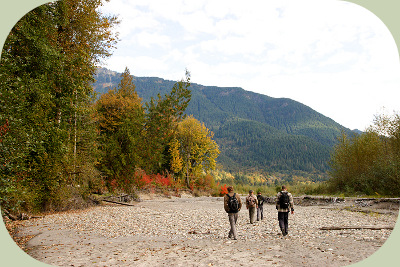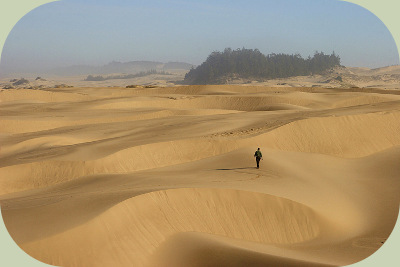I have spent much of my life practicing outdoor survival techniques and searching for lost or injured people in the backcountry and over the years one thing has become exceedingly clear to me, no one expects to get lost. Often it is this complacency combined with a lack of mental and physical preparation that gets people killed in the wilderness.
I am commonly asked by my students and friends “How do I live through a full survival situation?”. Most often I respond to this question with a sigh followed by the statement “Well, it’s complicated.”

Every survival scenario that one might encounter is really unique unto itself and requires different outdoor survival techniques. There are so many things that can factor in to a situation that it is really impossible to completely answer this question. Weather conditions; terrain; materials available for shelter, and fire; availability of drinkable water; physical tools available; skills level of the individual; comfort in the outdoors; potential injuries; not to mention if anyone even knows that you are missing; all factor in to a particular survival situation.
However, even with the complexities described above one can still prepare themselves for any potential situation giving themselves a much greater chance at survival with the proper outdoor survival techniques. The key word there was prepare, meaning in advance. One of my survival skills mentors told me once “You never want to be trying something for the first time when you need it to save your life.” I now consider this the golden rule of survival, preparedness.
I commonly divide outdoor survival techniques into three major categories: Mental preparation, physical skills, and tools available. Each of these three categories is equally important and one must not discount any one of them.
Mental preparation:
Though no one anticipates getting lost, you can still prepare yourself mentally for this scenario. In fact, often the act of being aware of the risk of getting lost or injured while in the backcountry can prevent a survival situation in the first place by creating an atmosphere of greater awareness.
One of the most important outdoor survival techniques is the ability to remain calm, or calm yourself if you panic, and look at the situation with a clear creative mind. Panic is your worst enemy in any type of life or death situation. Being aware that most people have the tendency to panic in these types of situations and being on the look out for the symptoms of panic in yourself is an important part of your outdoor survival techniques and knowledge.
If you feel yourself beginning to panic stop what you are doing, sit down, take some deep breaths and calm yourself. You will not be able to help yourself or others if you are not of clear mind.

Physical Skills:
Be honest with yourself about your skills with outdoor survival techniques and practice the skills of survival in controlled circumstances before you are placed in a potentially life threatening situation. Practice making fires in various weather conditions utilizing natural materials. Build a shelter near your house or while on a camping trip and spend the night in it. If you get too cold you can always abandon the shelter and climb back into your bed or sleeping bag. In the morning revisit the shelter, figure out what went wrong, correct it, and try again.
When you are out hiking constantly quiz yourself on what materials you would use to build a fire, where you would build a shelter to protect you from the elements and how it would be constructed, where the closest water sources are etc as a way to practice your outdoor survival techniques.
Tools:
Supplement your physical outdoor survival techniques by creating a survival pack for yourself. You can fit all of the necessities in a small waist pack that you can take out into the field with you when hiking or hunting. A small pack containing well thought out materials can make all the difference in the world in a life or death situation.
Students of outdoor survival techniques often have a goal of having the ability to survive any situation with nothing but the clothes on their backs. However, one must recognize that to have this ability one must put in many years of practice and intense training. Be honest about where your skills are at and pack your survival pack accordingly, your life may depend on it.
Even if you never find yourself in a life or death survival situation, an increase in your ability to take care of yourself in the outdoors using proper outdoor survival techniques will bring a sense of freedom and self sufficiency that is very rewarding. Remember, learning to survive in the wilderness is a lifelong journey where the individual pursuing the knowledge and freedom is constantly evolving and growing. In the western world we are often quick to just want to know a skill immediately.

With something as complex as outdoor survival techniques this is not possible. So don’t be hard on yourself if you only practice these things every now and then. Even practicing a little bit here and there adds up to a great deal of knowledge experience over time. Perhaps most importantly it is vital to just enjoy the process, have fun, and appreciate all of the amazing places and connections that you will make along the way. Good luck on your journey.
Recommended outdoor survival techniques pack item list:
These are the basic things that I would put in a day use waist pack. You would be surprised at how little space all of this will take up (small fanny pack) and how little it weighs. When you are not using it for hiking it is good to keep the pack in your car for emergency situations.
Make sure that you put everything in plastic baggies so your stuff won’t get wet, plus the baggies will come in handy for collecting plants and/or hauling and storing water.
- Lighter
- Quality matches (in a plastic baggie) waterproof matches are great. If they aren’t strike anywhere matches make sure you keep the striker from the box.
- Small flint striker
- Some type of flexible sealable water container (available at REI)
- Non-folding knife (make sure it is sharp): I really like a brand of knife called “Frost” or “Mora” they are really cheap (in the $15 dollar range) very durable, great for carving and splitting wood, and they are really easy to sharpen. I personally like the Frosts Craftsmen’s Mora Knife Model 760 with a plastic handle vs the wood handled knives which I think are less durable. You can order them online at many online knife stores, like the following link http://www.swedishknives.com/ or you can purchase them at the Alderleaf School Store.
- Some type of quick fire starter (Vaseline soaked cotton balls work very well): Warm the Vaseline in the oven (or microwave) in a bowl. Watch out it can get very hot and burn you badly if you over heat it. Saturate each cotton ball with the Vaseline and then place the soaked balls in a small container that won’t leak if the Vaseline warms up in the sun. A lot of cotton balls can be jammed into a small container. Each ball will burn on its own for quite a long time and work great for fire starting. They can be started with matches, lighter, or flint striker. Try them out when you soak them so that you can get an idea of how they work. One advantage to these is that they are cheap and completely waterproof.)
- Emergency poncho (if you use it be really careful not to rip it) get a bright colored one for high visibility and potentially signaling rescue
- Thick black trash bag
- Compass
- Small pencil and note pad (not critical, but can come in handy)
- Small first aid kit: Antibiotic ointment, band aids, Benadryl, pain killers, one or two gauze pads for larger wounds and a small amount of medical tape (you can buy really small first aid kits from REI prepackaged and add a few essentials to them like Benadryl.
- Some type of light metal cup (water containers are one of the hardest things to create in a survival situation so this cup will allow you to boil water and cook food (soups, teas, and stew)
- Iodine tabs for water purification
- Small saw (can be small cable finger saw to save space if needed, some work better than others) tip- put sticks through the end rings instead of your fingers. Some people prefer to pack a multi-tool containing a saw in their packs.
- Small foil emergency blanket (this can be used to waterproof a shelter and make it warmer by reflecting the heat back on to you, as a ground cloth, or to reflect the heat of a fire back onto you or into your shelter.
- Small flashlight with extra batteries (small LEDs work great but make sure it is a light that has a steady on-off button, not one that you have to constantly hold on)
- A few hard candies or throat lozenges
- A couple of packets of Emergen-C
- chapstick
- Small whistle
- Signal mirror
- 1 or 2 Original style power bars (two reasons for original 1. They taste terrible so you won’t be tempted to eat it unless you are really needing it. 2. The wrapper can be used as eye protection from the sun just like sunglasses {try it, the wrapper is see through when you put it up to your face but will block out the sun. It is especially important in snow conditions to protect your eyesight})
- Paracord (the type with a bunch of smaller strands inside) this is strong stuff and if needed you can pull out the smaller strands and use them for other projects like traps, fishing, or shelter making)
- A couple of small fishing hooks, weights, and some light fishing line (10 yards or so should work. I like 4 or six lb test) you can put this stuff all in a small film canister or similar container.
- I like to put a couple of small dry flies (for fly fishing) in as well for floating on the top of the water (make sure they have barbed hooks on them as opposed to un-barbed which are for catch and release. You will want to catch and eat) I recommend the mosquito flies since mosquitoes are everywhere, fortunately and unfortunately.
- Candle (great for starting fires or warming a snow cave) I personally like the 12 hour beeswax candles, but they are a bit bulky.
- A small container of sunscreen can be good to add
- Also, they sell DEET wipes in individual packets now for keeping the bugs off (trust me they can really drive you mad and you will wish you had this if you don’t pack it. They really take up almost no space at all)
- If you want to get fancy you can buy some steel wire small game snares and put them in the pack as well.

source : Dave Scott



